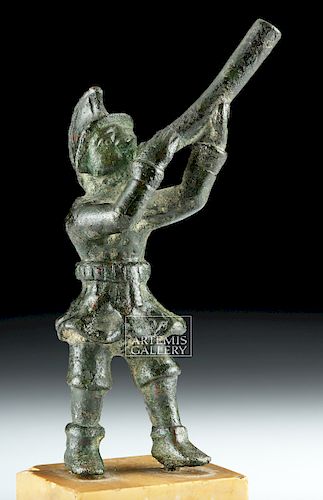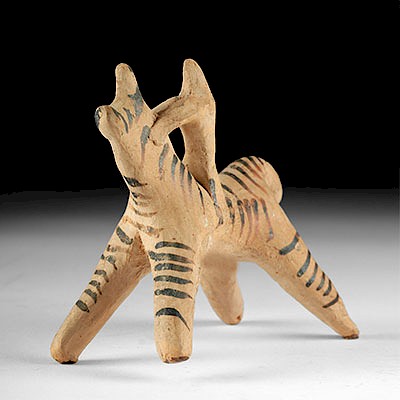Gallo-Roman Bronze Soldier / Military Buccinator
Lot 55a
About Seller
Artemis Fine Arts
686 S Taylor Ave, Ste 106
Louisville, CO 80027
United States
Selling antiquities, ancient and ethnographic art online since 1993, Artemis Gallery specializes in Classical Antiquities (Egyptian, Greek, Roman, Near Eastern), Asian, Pre-Columbian, African / Tribal / Oceanographic art. Our extensive inventory includes pottery, stone, metal, wood, glass and textil...Read more
Estimate:
$4,000 - $6,000
Absentee vs Live bid
Two ways to bid:
- Leave a max absentee bid and the platform will bid on your behalf up to your maximum bid during the live auction.
- Bid live during the auction and your bids will be submitted real-time to the auctioneer.
Bid Increments
| Price | Bid Increment |
|---|---|
| $0 | $25 |
| $300 | $50 |
| $1,000 | $100 |
| $2,000 | $250 |
| $5,000 | $500 |
| $10,000 | $1,000 |
| $20,000 | $2,500 |
| $50,000 | $5,000 |
| $100,000 | $10,000 |
| $200,000 | $20,000 |
About Auction
By Artemis Fine Arts
Oct 25, 2018
Set Reminder
2018-10-25 11:00:00
2018-10-25 11:00:00
America/New_York
Bidsquare
Bidsquare : Antiquities from Egypt, Greece, Italy, Asia
https://www.bidsquare.com/auctions/artemis-gallery/antiquities-from-egypt-greece-italy-asia-3538
Featuring Egyptian, Greek, Roman, Etruscan, Near Eastern, plus Asian art from Central and Far East. If you love the classics, this is the sale for you. Artemis Fine Arts info@artemisgallery.com
Featuring Egyptian, Greek, Roman, Etruscan, Near Eastern, plus Asian art from Central and Far East. If you love the classics, this is the sale for you. Artemis Fine Arts info@artemisgallery.com
- Lot Description
Roman Gaul / Gallo-Roman, ca. 1st to early 5th century CE. A cast bronze sculpture depicting a Roman soldier acting as a buccinator - blowing a buccina, a type of brass instrument. He stands in a lifelike pose, with his clothing - heavy boots, leggings, skirted tunic, and crested helmet - all nicely detailed. He holds the buccina up with both hands. The hands and face are also well sculpted. Pegs extending from the bottom of the feet indicate that this statue was made to be placed into something decoratively. Size: 2.75" W x 4" H (7 cm x 10.2 cm); 5.8" H (14.7 cm) on included custom stand.
The buccina - similar to the cornu - was a 3 meter (nearly 10 foot!) long instrument curved into the shape of the letter G; the figure here holds roughly 1/3 of the original item. It was braced by a crossbar that would rest upon the player's shoulder. We know this from the remains of two similar instruments that were found at Pompeii. Buccinae were used by the Roman army to announce different orders to the troops, including summoning soldiers and announcing watches. For example, Frontinus tells the story of a daring escape by a Roman general who, surrounded by the enemy, left behind his buccinator, who sounded the watches throughout the night (history does not relate how the buccinator felt about this). The instrument is the ancestor of the trumpet and the trombone.
Provenance: private East Coast, USA collection
All items legal to buy/sell under U.S. Statute covering cultural patrimony Code 2600, CHAPTER 14, and are guaranteed to be as described or your money back.
A Certificate of Authenticity will accompany all winning bids.
We ship worldwide and handle all shipping in-house for your convenience.
#137791End of instrument is an ancient loss. Dark patina on surface with nice remaining detail. Attached to a recent stone stand by some kind of adhesive.Condition
- Shipping Info
-
All shipping is handled in-house for your convenience. Your invoice from Artemis Gallery will include shipping calculation instructions. If in doubt, please inquire BEFORE bidding for estimated shipping costs for individual items.
-
- Buyer's Premium



 EUR
EUR CAD
CAD AUD
AUD GBP
GBP MXN
MXN HKD
HKD CNY
CNY MYR
MYR SEK
SEK SGD
SGD CHF
CHF THB
THB














